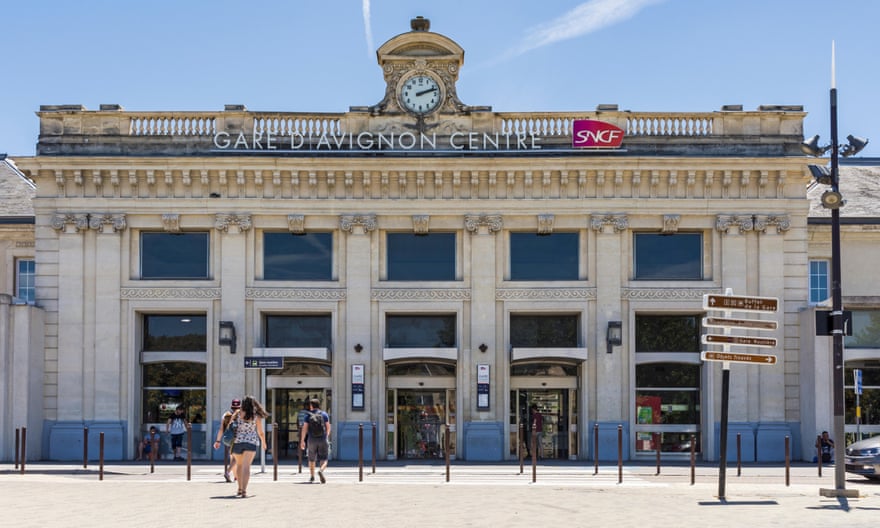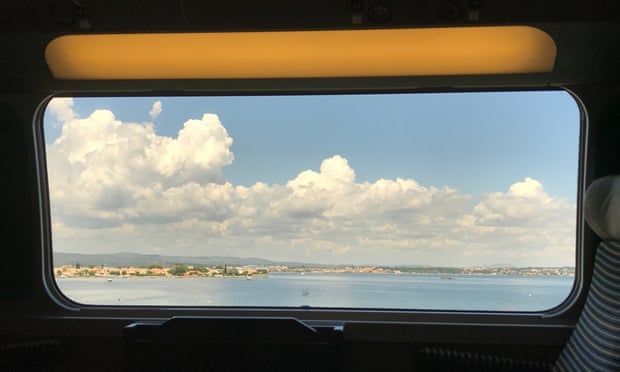Rail route of the month: the slow train from France to Spain | Rail travel
Avignon is a natural way station for travellers from Britain and northern Europe bound for the Iberian peninsula. It’s a place for choices. Fast or slow?
Travellers in a rush to reach Spain head for the Gare TGV, which opened in 2001. It is a good way south of the city centre in Courtine, a new suburb that was once a watery wasteland between the Durance and Rhône rivers. From that rather sterile out-of-town station, a high-speed train leaving at 8.40am gets to the Spanish capital by mid-afternoon.
Those not in a hurry will find a far more interesting option for travel to Spain. The slow trains depart from Avignon Centre, the historic station by the walls of the old city. The station itself is a gem, its facade an essay in neo-classical symmetry, with five elegant bays and a clock dominating the balustrade. Architect Jules Bouchot also designed a similar station at Valence, down the Rhône Valley from Avignon. Both stations take architectural cues from the 7 chateau at Versailles.

Avignon Centre once boasted a roll call of international destinations on its departure boards. Alas, the direct trains to London, Berlin and Milan are no more. The only trains from Avignon Centre that still venture beyond French borders are the thrice-daily regional services to Portbou in Spain. This is an extraordinary 4hr 15min journey made all the better by being on a slower train, which makes 25 stops en route. There’s real drama in the changing landscapes on this route, culminating in a final stretch along the Côte Vermeille south of Perpignan to the border. On the left is the Mediterranean, and the rugged slopes of the Pyrenees rise up away to the right. All in all it’s far better than diving under the mountains in the long Perthus tunnel used by the high-speed trains.
This slower option relies on regional trains (TERs) . Up to three direct trains a day run from Avignon to Portbou. These are augmented by additional services which require changes, commonly at Narbonne and Perpignan. This is the perfect journey for travellers using Interrail passes: they can just hop on and off at will without the tiresome requirement, common in France, to reserve seats in advance. It’s a route to be enjoyed in its own right, but can be built into longer Interrail itineraries.
Cruising through Occitanie
The slow train to Spain slips through Avignon’s southern suburbs and crosses the Durance east of the TGV station. Within just a few minutes there’s a real sense of wilderness as we skirt the steep slopes of La Montagnette, with their twisted pines and low maquis, a landscape shaped by the unforgiving mistral wind. There is a wonderful sense of being immersed in a landscape, rather than dashing through it at an uncomfortably high speed.

At Tarascon the train turns decisively west, crossing the Rhône and entering Occitanie. We pass a rose-coloured farmhouse flying the region’s distinctive red flag with a yellow cross. The train stops at a station called Nîmes Pont-du-Gard. It’s a bold piece of modern architecture and a curious affectation of French rail planners: the station is miles from Nîmes and even further from the celebrated Roman aqueduct that forms the rest of its name. Later we stop at real Nîmes, then at a procession of distinctive Occitan communities: Montpellier, Sète, Agde, Béziers and Narbonne. Along the way, there are tantalising views of flamingos, salt pans, coastal fortresses and empty beaches.
I’ve ridden this route from end to end without a break. It takes just over four hours. But the places along the way are just too tempting to miss. Narbonne is roughly the midpoint of the journey and the perfect spot for lunch. Make for Les Halles, a historic covered market that looks like a 19th-century railway station, for a variety of culinary treats.
I also usually stop at Perpignan, where a sign at the station reminds travellers that Perpignan is the very centre of the world. This is not an idle piece of civic pretension, but a nice reference to Salvador Dalí’s extraordinary metaphysical experience here in 1963. For Dalí, Perpignan was not merely the centre of the world, but the centre cosmique de l’univers.

The other unmissable spot on this journey is lovely Collioure, a small port on the rocky coast south of Perpignan. The village is overlooked by a fine 13th-century castle used by Knights Templar, Mallorcan monarchs and Bourbon troops. Matisse, Picasso, Dufy and Braque all discovered Collioure. The anchovies, for so long a Collioure staple, are as good as ever and the town still attracts many aspiring artists. From Collioure, the railway skirts capes and bays, passing the windswept vineyards at Banyuls along the way.
Read More: Rail route of the month: the slow train from France to Spain | Rail travel

